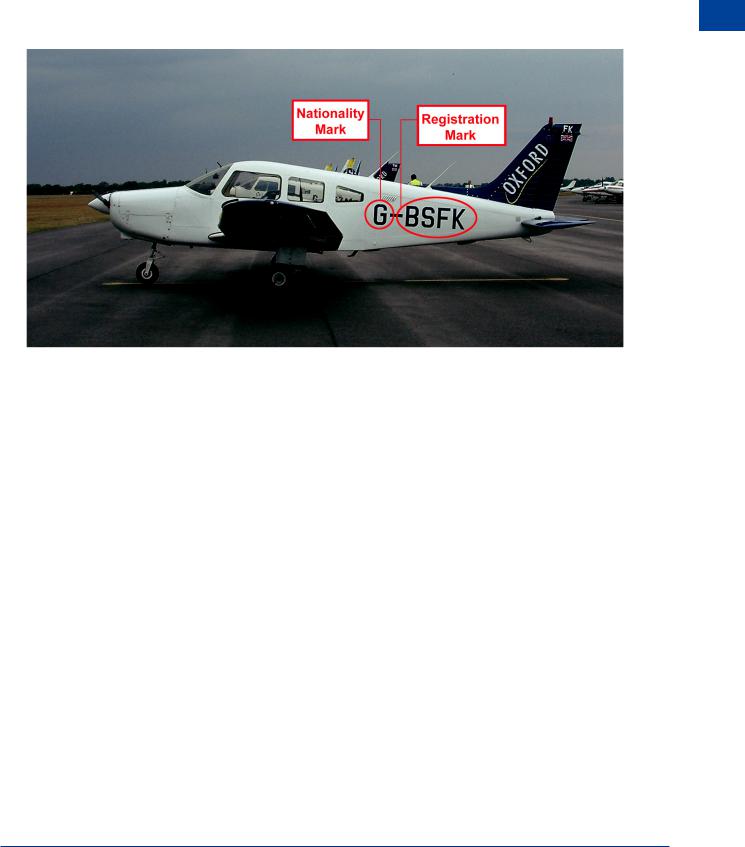
- •Textbook Series
- •Contents
- •1 Definitions
- •Introduction
- •Abbreviations
- •Definitions
- •2 International Agreements and Organizations
- •The Chicago Convention
- •International Law
- •Commercial Considerations
- •Customs and Excise, and Immigration
- •International Obligations of Contracted States
- •Duties of ICAO Member States
- •Status of Annex Components
- •The International Civil Aviation Organization (ICAO)
- •The Organization of ICAO
- •Regional Structure of ICAO
- •Regional Structure and Offices
- •ICAO Publications
- •Other International Agreements
- •The Conventions of Tokyo, the Hague and Montreal
- •The Warsaw Convention
- •The Rome Convention
- •IATA
- •ECAC
- •EASA
- •Eurocontrol
- •World Trade Organization
- •Geneva Convention
- •EU Regulation 261/2004
- •Questions
- •Answers
- •3 Airworthiness of Aircraft
- •Introduction
- •Airworthiness
- •Questions
- •Answers
- •4 Aircraft Nationality and Registration Marks
- •Introduction
- •Nationality and Registration Marks
- •Certification of Registration
- •Aircraft Markings
- •Classification of Aircraft
- •Questions
- •Answers
- •5 Flight Crew Licensing
- •Introduction
- •Definitions
- •General Rules Concerning Licensing
- •Licences and Ratings for Pilots
- •Multi-crew Pilot Licence (MPL)
- •Instrument Rating (Aeroplane) (IR(A))
- •Instructor and Examiner Rating
- •JAR-FCL 3 Medical Requirements
- •Pilot Proficiency
- •EASA Theoretical Knowledge Examinations
- •Questions
- •Answers
- •6 Rules of the Air
- •History
- •Applicability of the Rules of the Air
- •General Rules
- •Visual Flight Rules
- •Instrument Flight Rules
- •Semi-circular Flight Level Rules and RVSM
- •Special VFR
- •Distress and Urgency Signals
- •Restricted, Prohibited or Danger Areas
- •Signals for Aerodrome Traffic
- •Marshalling Signals
- •Flight Deck Signals
- •Questions
- •Answers
- •Instrument Procedures
- •PANS OPS
- •Instrument Departure Procedures
- •Questions
- •Answers
- •8 Approach Procedures
- •Procedure Basics
- •Approach Procedure Design
- •Obstacle Clearance Altitude/Height
- •Operating Minima
- •Descent Gradients
- •Track Reversal and Racetracks
- •Missed Approach Segment and Procedure
- •Published Information
- •RNAV Approach Procedures based on VOR/DME
- •Questions
- •Answers
- •9 Circling Approach
- •Circling Approach
- •Questions
- •Answers
- •10 Holding Procedures
- •Holding Procedures
- •Entry Sectors
- •ATC Considerations
- •Obstacle Clearance
- •Questions
- •Answers
- •11 Altimeter Setting Procedure
- •Altimeter Setting Objectives
- •Transition
- •Phases of Flight
- •Questions
- •Answers
- •12 Parallel or Near-parallel Runway Operation
- •Safety
- •Runway Spacing
- •Questions
- •Answers
- •13 SSR and ACAS
- •Airborne Collision Avoidance System (ACAS)
- •Questions
- •Answers
- •14 Airspace
- •Introduction
- •Control Areas and Zones
- •Classes of Airspace
- •Required Navigation Performance (RNP)
- •Airways and ATS Routes
- •Questions
- •Answers
- •15 Air Traffic Services
- •Introduction
- •Air Traffic Control
- •ATC Clearances
- •Control of Persons and Vehicles at Aerodromes
- •The Flight Information Service
- •The Alerting Service
- •Procedures
- •Questions
- •Answers
- •16 Separation
- •Concept of Separation
- •Vertical Separation
- •Horizontal Separation
- •Radar Separation
- •Procedural Wake Turbulence Separation
- •Radar Wake Turbulence Separation
- •Visual Separation in the Vicinity of Aerodromes
- •Stacking
- •Questions
- •Answers
- •17 Control of Aircraft
- •Procedural ATC
- •Radar Control
- •Radar Identification
- •Radar Service
- •Aerodrome Control
- •Approach Control Service
- •Air Traffic Advisory Service
- •Aircraft Emergencies
- •Questions
- •Answers
- •18 Aeronautical Information Service (AIS)
- •Introduction
- •General
- •The Integrated Aeronautical Information Package
- •The Aeronautical Information Publication (AIP)
- •Notices to Airmen (NOTAM)
- •SNOWTAM
- •ASHTAM
- •Aeronautical Information Circulars (AICs)
- •Pre-flight and Post-flight Information
- •Questions
- •Answers
- •Introduction
- •Aerodrome Reference Code
- •Glossary of Terms
- •Aerodrome Data
- •Runways
- •Taxiways
- •Aprons
- •Questions
- •Answers
- •Requirements
- •Visual Aids for Navigation
- •Runway Markings
- •Taxiway Markings
- •Signs
- •Markers
- •Visual Docking Guidance Systems
- •Questions
- •Answers
- •21 Aerodrome Lighting
- •Aerodrome Lights
- •Approach Lighting Systems
- •Runway Lighting
- •Taxiway Lighting
- •Questions
- •Answers
- •22 Obstacle Marking and Aerodrome Services
- •Introduction
- •Visual Aids for Denoting Obstacles
- •Visual Aids for Denoting Restricted Use Areas
- •Emergency and Other Services
- •Other Aerodrome Services
- •Questions
- •Answers
- •23 Facilitation
- •Entry and Departure of Aircraft
- •Questions
- •Answers
- •24 Search and Rescue
- •Definitions and Abbreviations
- •Establishment and Provision of SAR Service
- •Co-operation between States
- •Operating Procedures
- •Questions
- •Answers
- •25 Security
- •Introduction
- •Objectives
- •Organization
- •Preventative Security Measures
- •Management of Response to Acts of Unlawful Interference
- •Further Security Information
- •Questions
- •Answers
- •26 Aircraft Accident and Incident Investigation
- •Introduction
- •Objective of Investigation
- •Investigations
- •Serious Incidents
- •EU Considerations
- •Questions
- •Answers
- •27 Revision Questions
- •Revision Questions
- •Answers
- •EASA Specimen Examination
- •Answers to Specimen EASA Examination
- •28 Addendum – EASA Part-FCL & Part-MED
- •Chapter Five. Flight Crew Licensing
- •European Aviation Safety Agency (EASA)
- •Licences
- •Ratings
- •Certificates
- •EASA Part-MED
- •29 Index

Chapter
4
Aircraft Nationality and Registration Marks
Introduction |
|
|
|
|
|
63 |
Nationality and Registration Marks . . |
. . |
. . . . . . . . . . . . . . |
. . |
. . |
|
.63 |
Certification of Registration . . . . |
. . |
. . . . . . . . . . . . . . |
. . |
. . |
. |
64 |
Aircraft Markings . . . . . . . . |
. . |
. . . . . . . . . . . . . . |
. . |
. . |
. |
64 |
Classification of Aircraft . . . . . . |
. . |
. . . . . . . . . . . . . . |
. . |
. . |
|
.65 |
Questions . . . . . . . . . . . |
. . |
. . . . . . . . . . . . . . |
. . |
. . |
. |
66 |
Answers . . . . . . . . . . . . |
. . |
. . . . . . . . . . . . . . |
. . |
. . |
|
.68 |
61

4 Aircraft Nationality and Registration Marks
Marks Registration and Nationality Aircraft 4
62

Aircraft Nationality and Registration Marks |
|
4 |
|
||
|
|
|
Introduction
4.1 Annex 7. The Paris Convention of 1919 requires all aircraft to be registered and to carry a nationality mark and a registration mark. Annex 7 of the Chicago Convention covers Aircraft Nationality and Registration Marks. The annex contains only Standards without any recommendations. An Authority may temporarily exempt an aircraft from registration (test flying of a prototype) or the carriage of markings (an historic aircraft or ex-military aeroplane).
Figure 4.1
Nationality and Registration Marks
4.2.Differences
Annex 7 also contains lists of those Contracting States which have :
a.Notified ICAO of differences which exist between their national regulations and the International ICAO standards set down in Annex 7
b.Notified ICAO that no differences exist
c.Given no information to ICAO on this subject
4.3Markings. The nationality and registration mark is to consist of a group of characters.
G-ABCD
In this case G is the nationality mark and is always to precede the registration mark, in this case ABCD. When the first character of the registration mark is the same type of character as the last character of the nationality mark, it is be preceded by a hyphen (-). The nationality mark is selected from the series of nationality symbols included in the radio call signs allocated to the State of Registry by the International Telecommunications Union (an agency of the United Nations). The nationality mark is to be notified by the State of Registry, to ICAO and may consist of single letters, multiple letters or a combination of letters and numbers. It may also include a symbol of the State (e.g. the Red Cross in the case of Switzerland). The registration
Aircraft Nationality and Registration Marks 4
63

4 Aircraft Nationality and Registration Marks
Marks Registration and Nationality Aircraft 4
mark may consist of letters, numbers or a combination of both and is assigned by the State of Registry, or the common mark registering authority, from a list of available (not previously issued) marks applicable to the State of Registry.
4.4Common Mark. A common mark replaces a nationality mark where the aircraft is owned (operated) by an operator registered in more than one country. In this case, a ‘common mark’ is allocated by the ITU, and ICAO specifies a state to exercise the responsibilities of the State of Registry (known as the common mark registering authority). The common mark registering authority also performs the function of the State of Registry with regard to the continuing airworthiness of the aircraft. Presently, the common mark 4YB is issued by ICAO to Arab Air Cargo Incorporated (based in Jordan and Iraq) for registering aircraft operated by that organization. ICAO has specified that Jordan performs the other functions of the common mark registering authority.
4.5Exclusions. Certain combinations of letters are not permitted to be used as registration letters or parts of a registration mark. These are those combinations of letters used for specific distress traffic indicators or internationally accepted communication abbreviations. Specifically:
•SOS (Distress - morse)
•PAN (Urgency)
•XXX (Urgency - morse)
•TTT (Safety /Securité - morse)
•‘Q’ codes (i.e. QNH; QRT; QUG etc….)
•5 letter combinations of the international Code of Signals
Certification of Registration
4.6 Status and Content. The certificate of registration is an official document certifying that the State of Registry has registered an aircraft. The certificate is to be carried in the aircraft at all times. The certificate contains:
•Nationality or Common mark,
•Registration mark,
•Manufacturer’s designation of the aircraft,
•Serial number of the aircraft,
•Name and address of the owner,
•A certificate that it has been entered on the register of the State,
•Dated signature of the registering officer.
Aircraft Markings
4.7Location of Nationality and Registration Marks. The nationality or common mark and registration mark are to be painted on the aircraft or shall be affixed by any other means ensuring a similar degree of permanence. The marks shall be kept clean and visible at all times.
4.8Heavier than Air Aircraft. The required markings are to appear on the lower surface (underside) of the wing, the fuselage between the wings and the tail, or on the upper half of the vertical tail surface.
4.9Size of Markings. The markings on the wings are to be at least 50 cm high, and on the fuselage and vertical surfaces, 30 cm high.
64
